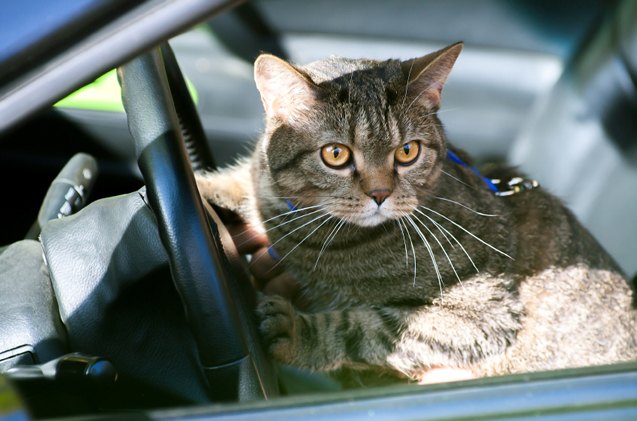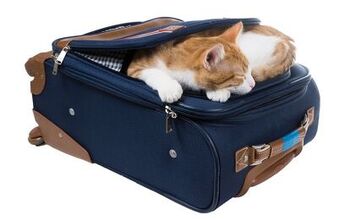Taking a trip with your kitty? Here are some tips to go over before you leave the house.
If you’re planning a trip, you might be tempted to take your beloved feline companion with you. After all, one way to make a vacation or camping trip even better is by having your four-legged bestie at your side! But your wish to share the adventure with your pet isn’t the only thing to consider when deciding whether you should bring him along or let him stay home with a pet sitter.
Some Cats and Travel Don’t Always Mix
Unlike dogs, cats generally don’t like to travel, and they can get stressed when you take them out of the environment that they’re used to. Sometimes, even moving to a new house can be nerve-wracking for a feline, so you can imagine what a road trip or vacation would do, considering those require being away from home for long stretches of time.
But not all cats are alike, of course, and some might be so easygoing that traveling doesn’t bother them. Some kitties even prefer getting out of the house and going on little adventures with their owners. And a surprising number of cats absolutely love exploring, and seek out opportunities for experiencing new surroundings. Just look at famous felines like Vladimir the traveling cat and Simon the backpacking kitty as a couple of examples.
Remember, every cat is an individual with a unique personality and preferences. And if you do decide that you want to take your pet on a short trip or a long vacation, there are steps you can take to help ensure the experience will be as enjoyable as possible for everyone involved.
First, Ask Yourself: Does Your Cat Really Want to Go on Vacation with You?
The first thing you need to consider is whether or not your cat would really enjoy going on vacation with you. Are you making the decision to bring him along because you will really miss him, and you don’t want to have to worry about him while you’re away from home and he’s all alone? Or do you think that going on a trip would be as fun for your pet as it would be for you?
The majority of felines would likely prefer to remain on their home turf, where they have their own routine, they’re familiar with the environment and what to expect every day, and they have their comfy bed and fun toys to play with. However, if your cat is an exception to the rule and one that actually does really well with changing environments and travel, you can go ahead and take him on the journey.
What if you aren’t the proud parent of an adventure cat? Well, if your pet is easily frazzled by change, or if he gets stressed when he has to go in his carrier or on a car ride, it is probably best to just let him stay home while you go on your getaway. Hiring a reputable cat sitter or having a friend or relative visit your cat a few times a day can help ensure he’ll be safe and have plenty of food, water, and clean litter until you get home. And this could also help you rest assured that any emergencies that might arise can be addressed promptly too.
Consult with Your Veterinarian for Advice
You can talk to your veterinarian about your plans for traveling with your cat, and he or she can give you some valuable advice and tips on how to make the journey a smooth and safe one for your pet. Plus, if you want to access remedies that can help keep your pet calm and happy during the trip, your vet can assist in this area as well.
Your vet can also examine your kitty prior to your trip to be sure he’s healthy enough to be away from home. And if your pet takes any prescription medications or is on a prescription diet, you can talk to your vet about making sure you have enough supply until you get back home.
Another thing to think about is whether or not your cat will need any special vaccinations, and if you’ll need to provide proof of an exam and vaccines. This may depend on your destination, so be sure to get all of the paperwork sorted and packed before you head off.
Related: Cats And Car Rides: How To Get Them To Mix
Make the Journey a Stress-Free Experience
Even if your kitty isn’t one of those that live for adventure and the great outdoors, you might still have no choice but to make him your traveling companion. For example, if you absolutely cannot find anyone you trust to pet sit while you’re away, your only option may be to take him with you. No matter the reason for taking your cat with you on a trip, it’s imperative that you do everything possible to make the journey as stress-free and safe as possible for your furry companion.
Depending on your mode of transportation, it’s wise to take steps to ensure your cat will be secure at all times and will remain as calm as possible. After all, traveling by car will be a different experience than traveling by plane. And you also need to consider how long you’ll be en route to your destination as well. For instance, there are various pet carriers and travel crates that you can use to safely transport your cat, but the one you select will depend on factors like the amount of space you have in your car or on the plane, and whether or not a specific type of carrier is required by an airline.
Plan Ahead to Pack Everything Your Cat Will Need
No matter how you plan on traveling, it’s critical that you pack the right products and supplies for your pet. After all, you’ll be far from home, and it might be difficult to find stores where you can make purchases quickly and easily when you need something in a pinch.
Here are some of the many products that you will need when traveling with your feline friend:
Litter box and litterFood and waterToys Blanket Cat bedCarrier EnclosureMedicationsCollar, ID tags, harness, and leash
Try Using Products That Can Help Keep Cat Calm While Traveling
A soft-sided carrier with a soft blanket and a familiar toy might help your cat feel at ease, as it will remind him of home. But, in addition to selecting the right carrier for comfort and security while you travel with your cat, there are also several products that you can use to help your pet feel as calm as possible.
When it comes to natural remedies that can help a kitty feel relaxed, options include:
Bach Flower Essences, such as Rescue Remedy Feline pheromone spraysHerbs, such as chamomile, catnip, and valerian
These types of products rely on natural ingredients that may calm down your pet without having to resort to medications. But, even though there are over-the-counter products that you can use to ease your pet’s anxiety naturally, keep in mind that it’s always a good idea to consult your veterinarian before trying anything new, as you’ll want to be sure a product is appropriate and safe for your companion. And, in the event that these options aren’t effective enough, you can talk to your vet about prescriptions that might be right for your kitty.
Tip: If your vet recommends a new remedy—whether it’s over-the-counter or a prescription—to help your cat travel, you may want to try it out in advance to see how your pet reacts to it. That way, you can be sure it’s safe to use when you’re away from home too.
Related: Sleepypod Pet Carriers Earn Top Honors from the Center for Pet Safety
Tips for Traveling by Car
Because train and bus companies may not allow pets onboard, the best option for traveling with your cat might be by car. If, however, your cat gets car sick or stressed, this could be a challenge.
There are anti-nausea medications for felines, so if your pet is prone to car sickness, consult with your veterinarian about possible treatments. And, no matter what, keep your kitty in his carrier, and strap the carrier to the car’s seat using a seatbelt in order to help keep him safe in the event of an accident.
Note: Most cats will be vocal at the beginning of a car ride, but they often quiet down and end up napping. If your cat is really stressed, though, you may need to get sedatives from your veterinarian to ensure a smooth journey.
Also, don’t forget to bring a small litter pan and litter for your cat to use in the car until you reach your destination. And, of course, be sure to pack plenty of fresh food and water, too. You can work on keeping your cat content by making sure he has some of his favorite treats and food to keep him satisfied during the trip.
Tips for Traveling by Plane
Traveling by plane can be stressful and sometimes dangerous for pets, especially when they’re placed in cargo. Therefore, it’s wise to make arrangements with your airline to bring your cat onboard with you.
The carrier you use to keep your pet secure should meet the airline’s requirements, so do research in advance to be sure you are fully prepared for the journey. For example, the airline might require that the carrier fit beneath your seat.
If you absolutely must put your pet in cargo, you need to be sure you purchase an appropriate carrier that’s properly labeled with your information and destination so you can be reunited with your pet if he’s accidentally misplaced at any point during your travels.
Tip: Booking a direct flight is usually a lot less traumatizing than taking multiple flights, and it also reduces the risk of your pet getting lost.
Book a Pet-Friendly Hotel
Many hotels don’t allow pets, so your choices may be limited. Again, when it comes to traveling with your kitty, it’s all about doing plenty of research in advance so you’ll know where to go and what to expect. By searching for a pet-friendly hotel, you can rest assured that you and your companion will have a clean and safe place to stay while you’re on vacation together.
Once you settle into your hotel room, it’s a great idea to set up a collapsible pet tent or other enclosure for your cat to stay in whenever you aren’t in the room. Even keeping your pet in a crate or carrier while you’re gone is wise. The last thing you’d want is for the housekeeper to open the door and let your cat out, or for your pet to dart out when you come back to your hotel room.
Another strategy you can use to help keep your cat safe while in the hotel room, and even while you’re both out and about together: have him wear a collar with ID tags to indicate who he belongs to. Make sure the tags display your contact information so people can get in touch with you if they find your lost pet.
Are You Hoping to Travel with Your Cat?
Vacationing with any pet can be difficult, but felines can be especially challenging. They tend to be reluctant to change their routine and be in unfamiliar environments. However, training your cat to tolerate travel, preferably at a young age, and taking steps to reduce your pet’s anxiety when you’re both on the go may help ensure your kitty can go on a fun getaway with you. Exposure to new experiences and surroundings, combined with socialization at an early age, might help you avoid behavioral issues down the road too, so even if you’re unsure if you’ll be traveling with your kitty when he grows up, it doesn’t hurt to socialize him for it just in case the need to take him on the road ever arises.

























